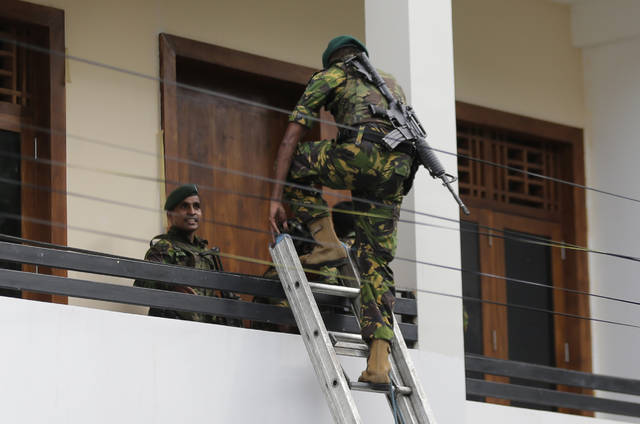'Panic mode': Witness describes aftermath of Sri Lanka bombs
Bhanuka Harischandra was running a little late for his meeting Sunday.
As a car carrying him pulled into the back entrance of the luxury Shangri-La Hotel in Sri Lanka’s capital of Colombo, he realized something was wrong.
People were telling him not to come in, it wasn’t safe. Still, the car pulled around to the front of the hotel and Harischandra saw the aftermath of a bombing. People were being evacuated, others were being dragged. Blood and ambulances were everywhere.
“It was panic mode,” Harischandra, a 24-year-old founder of a tech marketing company, said by telephone later in the day. “I didn’t process it for a while.”
Video shows the damage caused by some of the explosions at churches and hotels in Sri Lanka that killed more than 200 people and injured hundreds more on Easter Sunday. https://t.co/F5FTt2DfHV pic.twitter.com/PhJyuzxxI9
— ABC News (@ABC) April 21, 2019
He decided to go to the Cinnamon Grand Hotel, where he thought it would be safe. But just after he was dropped at the luxury hotel and about to enter the building, he heard another bomb go off.
Now he was being evacuated. Soot and ash fell on his white sweat shirt.
His car had left, so he hailed a motorized rickshaw and went to meet friends at a coffee shop. They contacted other friends, trying to make sure everyone they knew was safe.
It was too soon to think about what it might mean.
At least 8 bombing attacks struck at least 3 churches in Sri Lanka, along with 3 five-star hotels favored by foreigners, killing more than 200 people.
Read more: https://t.co/43Dcm0D9Si pic.twitter.com/Mzoe0Tl60b
— The New York Times (@nytimes) April 21, 2019
Over the course of the day, eight bombs exploded at churches and luxury hotels in and near Colombo, killing more than 200 people. The Easter Sunday violence was the deadliest the South Asian island country has seen since a bloody civil war ended a decade ago.
Many Sri Lankans remember well the terror of the 26-year war. But not Harischandra, who was just a teenager when it officially ended. In the past years, conflict was far from Colombo. Growing up, he was mostly aware of his parents’ anxiety about safety, not of actual fighting.
Now their anxiety is back.
“For them, it’s a bit of a different situation,” he said. “They’re afraid this might start racial violence.”
-At least 207 people were killed
-450 people are wounded
-Police say 13 suspects have been arrested
-No one has claimed responsibility for the attacks
-Sri Lanka's defense minister calls it a terrorist attack carried out by religious extremists https://t.co/XrUQglzbG0— NPR (@NPR) April 21, 2019
On Sunday night, he was with his family, observing a curfew. He said there was “a lot of tension” in the air, but he was also hoping that the worst might be over: It had been a few hours since the last blast.
Harischandra was heartened by the fact that his social media feed was flooded with photos of the lines of people waiting to give blood. Lines so long “you can’t see the end.”
Remove the ads from your TribLIVE reading experience but still support the journalists who create the content with TribLIVE Ad-Free.


